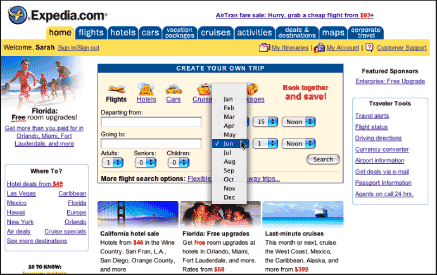Interactivity
Use add-ons for interactivity only when necessary
At times it may be useful for a Web page to update in response to user actions. For example, for a travel application, it would be useful if, after choosing a time frame for travel, the listing of available flights would update to show only flights available on those dates. This type of page-level interactivity is not native to the Web and can only be accomplished using add-ons such as Java, JavaScript, or Flash (Figure 13.1). Most current browsers support JavaScript natively, whereas other add-on technologies generally call for a plugin. Requiring a plugin for site access is risky, since many users will not have the plugin and may not be able, or will choose not, to install it.

Figure 13.1: Many sites use add-on technologies such as JavaScript to offer interactive features such as this calendar (1) on the Iberia site. These features often add complexity and hinder accessibility rather than improve usability. www.iberia.com
In addition, many of the accessibility features that are built into HTML are not available in other formats. For example, structural markup is not part of the Flash format. Users cannot customize Flash content. However, designers can take measures to make nonstandard content accessible. Current versions of Flash allow designers to add accessibility features, such as alternate text for images and captions for audio. But ultimately, HTML is a more flexible and accessible format, and reliance on other formats means that more users will be unable to access and use site content.
Before moving away from standard HTML constructs, consider carefully: Is the desired functionality necessary, or could the same effect be accomplished using standard HTML? Page-level interactivity may be a more elegant way to address a task such as booking a flight, but the task could certainly be accomplished using standard coding (Figure 13.2).

Figure 13.2: Expedia offers users simple dropdown menus for selecting travel dates. www.expedia.com
For universal usability, we need to understand and work with the strengths and limitations of the medium before turning to other, less-accessible formats.

